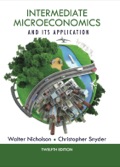
a)
To ascertain:The
a)
Answer to Problem 10.6P
The production possibility curve for region A
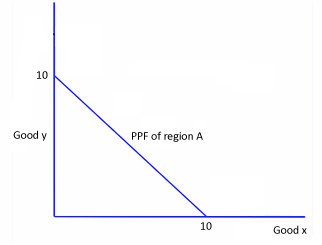
The production possibility curve for region B
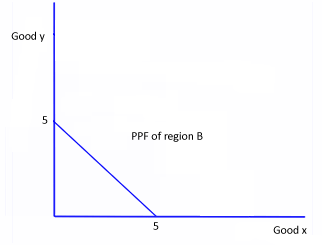
Explanation of Solution
To calculate the production possibility curves for region A, consider the following production
function for region A:
Here, Ix, is the labor allocated in the production of good x and I, is the labor allocated in the
production of good y
The total amount of labor available to region A is 100, that is,
From the production function, compute the value of Ixand Iy, as follows:
Now, substitute the value of Ix, and Iy, in the equation of total available labor and compute the
production function as follows:
Hence, the production for region
The PPF curve for region A is shown below:
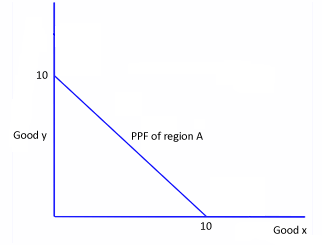
In this graph the vertical axis shows production of good y and horizontal axis shows production of good x.
To calculate the production possibility curves for region B, consider the following production
function for region B:
Here, Ixis the labor allocated in the production of good x and Iyis the labor allocated in the
production of good y .
The total amount of labor available to region A is 100, that is,
From the production function, compute the value of Ix and Iyas follows:
Now, substitute the value of Ix and Iy and in the equation of total available labor and compute theproduction function as follows:
Hence, the production of region B is
The PPF curve for region B is shown below:
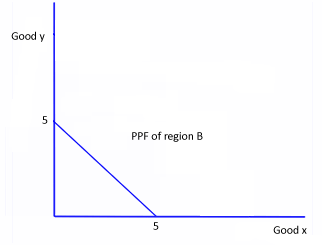
In the above graph, the vertical axis shows the production of good y and the horizontal axisshows the production of good x.
Introduction: Production possibilities of frontier is referring to specify the highest production combination of two products or services by the fixed amount of investment.
b)
To ascertain:conditions behind work allotted in region A and B.
b)
Answer to Problem 10.6P
The condition must hold for production allocation in country R between regions is
Explanation of Solution
To allocate the production efficiently in a region, the rate of production transformation (RPT) mustbe equal to the marginal rate of substitution (MRS).
Mathematically, the following condition musthold:
To allocate the production of two goods efficiently in the region A, the following condition musthold:
Hence, the rate of production transformation (RPT) in region A is
To allocate the production of two goods efficiently in region B, the following condition must hold:
Hence, the rate of production transformation (RPT) in region B is
To achieve the production
Hence, the condition must hold for production allocation in country R between regions is
Introduction: The marginal rate of production transformation is can be described as number of quantity of product that inevitable in order to attain a unit of another product.
c)
To ascertain:production possibility curve for a country.
c)
Answer to Problem 10.6P
The PPF for a country R is shown below:
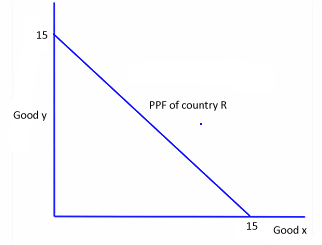
Explanation of Solution
To determine the combined PPF for a country R,
first, calculate the combine production function asfollows:
Region A
Region B
Equate the Ix , and Iy , as follows:
Combine production function is shown below:
Thus, the combined PPF is
The total output of x is 12. Substitute the value of x in the above combined PPF and calculate the
output of y as follows:
Hence, the total output of y produced in a country is 9
The PPF for a country is shown below:
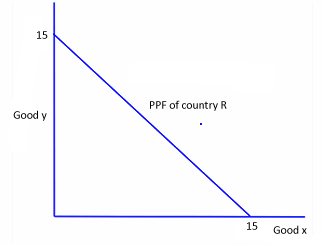
Introduction: Production possibilities of frontier is referring to specify the highest production combination of two products or services by the fixed amount of investment.
d)
To ascertain:production possibilities frontier for whole country.
d)
Answer to Problem 10.6P
If the labor is mobile within the country the production can be increased by allocating the resources in the favor of the more productive region.
Explanation of Solution
The PPF for the whole country can be developed for the whole country in the same way the PPF has been calculated for country R with two regions
If the labor is mobile within the country the production can be increased by allocating the resources in the favor of the more productive region.
Introduction: Production possibilities of frontier is referring to specify the highest production combination of two products or services by the fixed amount of investment.
Want to see more full solutions like this?
Chapter 10 Solutions
EBK INTERMEDIATE MICROECONOMICS AND ITS
- Dummy variables News reports claim that in the last year television watching has increased. You believe that rising unemployment during Covid may be one of the causes for this. Suppose you are interested in looking at the effect of being unemployed on the hours spent watching Netflix per day. You collect data on 10,000 people from Chicago who are between the age of 20 and 60. You define the dummy variable Unemployed which takes the value 1 for those who are unemployed and 0 for those who are employed. Equation 1: Hours spent watching Netflix₁ = ßo + B₁Unemployed; + ε¿ Following is the output for equation 1: reg hours spent_watching_netflix unemployed Source SS df MS Number of obs 10,000 F(1, 9998) = 14314.03 Model Residual 3539.70065 2472.39364 9,998 1 3539.70065 .247288822 Prob F R-squared == 0.0000 = 0.5888 Total 6012.09429 9,999 . 601269556 Adj R-squared Root MSE = 0.5887 .49728 hours spen~x Coef. Std. Err. t P>|t| [95% Conf. Interval] unemployed cons 1.189908 .0099456 119.64…arrow_forward17. The South African government's distributive stance is clear given its prioritisation of social spending, which includes grants and subsidised goods. Discuss the advantages and disadvantages of an in-kind subsidy versus a cash grant. Use a graphical illustration to support your arguments. [15] 18. Redistributive expenditure can take the form of direct cash transfers (grants) and/or in-kind subsidies. With references to the graphs below, discuss the merits of these two transfer types in the presence and absence of a positive externality. [14] 19. Expenditure on education and healthcare have, by far, the biggest redistributive effect in South Africa' by one estimate dropping the Gini-coefficient by 10 percentage points. Discuss the South African government's performance in health and education provision by evaluating both the outputs and outcomes in these areas of service delivery. [15] 20. Define the following concepts and provide an example in each case: tax rate structure, general…arrow_forwardSummarise the case for government intervention in the education marketarrow_forward
- Should Maureen question the family about the history of the home? Can Maureen access public records for proof of repairs?arrow_forward3. Distinguish between a direct democracy and a representative democracy. Use appropriate examples to support your answers. [4] 4. Explain the distinction between outputs and outcomes in social service delivery [2] 5. A R1000 tax payable by all adults could be viewed as both a proportional tax and a regressive tax. Do you agree? Explain. [4] 6. Briefly explain the displacement effect in Peacock and Wiseman's model of government expenditure growth and provide a relevant example of it in the South African context. [5] 7. Explain how unbalanced productivity growth may affect government expenditure and briefly comment on its relevance to South Africa. [5] 8. South Africa has recently proposed an increase in its value-added tax rate to 15%, sparking much controversy. Why is it argued that value-added tax is inequitable and what can be done to correct the inequity? [5] 9. Briefly explain the difference between access to education and the quality of education, and why we should care about the…arrow_forward20. Factors 01 pro B. the technological innovations available to companies. A. the laws that regulate manufacturers. C. the resources used to create output D. the waste left over after goods are produced. 21. Table 1.1 shows the tradeoff between different combinations of missile production and home construction, ceteris paribus. Complete the table by calculating the required opportunity costs for both missiles and houses. Then answer the indicated question(s). Combination Number of houses Opportunity cost of houses in Number of missiles terms of missiles J 0 4 K 10,000 3 L 17,000 2 1 M 21,000 0 N 23,000 Opportunity cost of missiles in terms of houses Tutorials-Principles of Economics m health carearrow_forward
- In a small open economy with a floating exchange rate, the supply of real money balances is fixed and a rise in government spending ______ Group of answer choices Raises the interest rate so that net exports must fall to maintain equilibrium in the goods market. Cannot change the interest rate so that net exports must fall to maintain equilibrium in the goods market. Cannot change the interest rate so income must rise to maintain equilibrium in the money market Raises the interest rate, so that income must rise to maintain equilibrium in the money market.arrow_forwardSuppose a country with a fixed exchange rate decides to implement a devaluation of its currency and commits to maintaining the new fixed parity. This implies (A) ______________ in the demand for its goods and a monetary (B) _______________. Group of answer choices (A) expansion ; (B) contraction (A) contraction ; (B) expansion (A) expansion ; (B) expansion (A) contraction ; (B) contractionarrow_forwardAssume a small open country under fixed exchanges rate and full capital mobility. Prices are fixed in the short run and equilibrium is given initially at point A. An exogenous increase in public spending shifts the IS curve to IS'. Which of the following statements is true? Group of answer choices A new equilibrium is reached at point B. The TR curve will shift down until it passes through point B. A new equilibrium is reached at point C. Point B can only be reached in the absence of capital mobility.arrow_forward
- A decrease in money demand causes the real interest rate to _____ and output to _____ in the short run, before prices adjust to restore equilibrium. Group of answer choices rise; rise fall; fall fall; rise rise; fallarrow_forwardIf a country's policy makers were to continously use expansionary monetary policy in an attempt to hold unemployment below the natural rate , the long urn result would be? Group of answer choices a decrease in the unemployment rate an increase in the level of output All of these an increase in the rate of inflationarrow_forwardA shift in the Aggregate Supply curve to the right will result in a move to a point that is southwest of where the economy is currently at. Group of answer choices True Falsearrow_forward




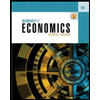 Survey of Economics (MindTap Course List)EconomicsISBN:9781305260948Author:Irvin B. TuckerPublisher:Cengage Learning
Survey of Economics (MindTap Course List)EconomicsISBN:9781305260948Author:Irvin B. TuckerPublisher:Cengage Learning





